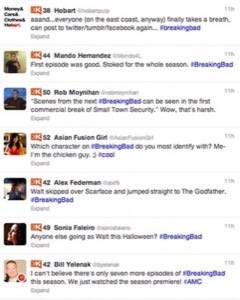
The popular TV drama Breaking Bad returned to television last night for a fifth season. The premiere was accompanied by a flood of tweets, check-ins and status updates across a variety of services, as has become standard during big entertainment events like this. At the same time, the Breaking Bad premiere demonstrated the rapid evolution of social TV and the second screen.
For fans of Breaking Bad, the Internet chatter began long before the opening scene of last night’s episode. AMC started generating buzz about the premiere several weeks ago through the show’s official Facebook and Twitter accounts.
On Facebook, this activity involved straightforward promotional tactics like posting trailers for the new season and related photos. But it also went well beyond the standard fare by including things like Spotify playlists, photo caption contests and show trivia. As the new episode approached, these posts became more frequent and engaging, often reminding viewers of the date and time of the impending premiere.
The Growth of the TV Check-in

AMC also gave an official push to the “check-in” category of entertainment apps by partnering with Get Glue. In the weeks leading up to the premiere, the cable channel enticed viewers with a virtual Breaking Bad sticker, which could be unlocked by checking into the program.
The gambit worked. A few minutes into the episode, more than 10,000 viewers had checked in to Breaking Bad on GetGlue. After checking in, users were presented with a Twitter-style stream of comments, allowing them to interact with one another in real time. It’s not unlike the social chatter that typically happens on Twitter (of which there was plenty during the debut), but it’s self-contained and thus less disruptive to uninterested users.
By the time last night’s episode was over, GetGlue saw 27,690 check-ins, the company told ReadWriteWeb. This represents a 232% increase over check-ins during the premiere of Breaking Bad’s fourth season last July. Evidently, the popularity of checking in to TV shows, as through they were real-world venues, is growing.
AMC Takes Advantage of the Second Screen
Social media chatter about popular television programs happens organically these days, with or without the producer’s participation. Networks, cable channels and even Twitter itself have realized this and begun to formally tighten the relationship between TV and the social Web.

AMC is clearly not sitting this one out. The channel was not only proactive about building social media buzz on Facebook, Twitter and GetGlue; it also launched its own second screen experience in the browser. Breaking Bad Story Sync, as the feature is called, provided supplementary content as the episode aired. In many cases, it was as simple as a poll asking viewers for their opinions about something that had just happened in the show. The auto-refreshing feed also included graphics and quotes from previous episodes, which provided pertinent context and details at precisely the right moments.
Figuring Out the Second Screen

Observing the social Web and TV-specific apps during a major television event, it’s apparent that we’re still figuring out exactly how and why to use our second (or third) screens. Many people live-tweet their thoughts as the episode progresses, sometimes to the irritation of Twitter followers who have no interest in the show. Apps such as GetGlue provide a filtered solution for that type of chatter, but they’re young and still growing their user bases. Miso, a competitor to GetGlue, has the check-in functionality but lacks real-time chatter, so engagement is limited.
There’s also the issue of fractured attention spans. Checking in, tweeting and answering viewer polls during a television show are fun, but viewers still actually need to, um, pay attention to the episode’s plot as it unfolds.
The kinks are still being ironed out, but the trends toward social TV and the second screen are indisputably growing. The majority of smartphone and tablet owners use their devices while they’re watching TV, according to Nielsen. For some, it’s to look up related content while others prefer to converse with their fellow viewers. Little by little, networks, producers and viewers are converging on a new way to watch TV.










